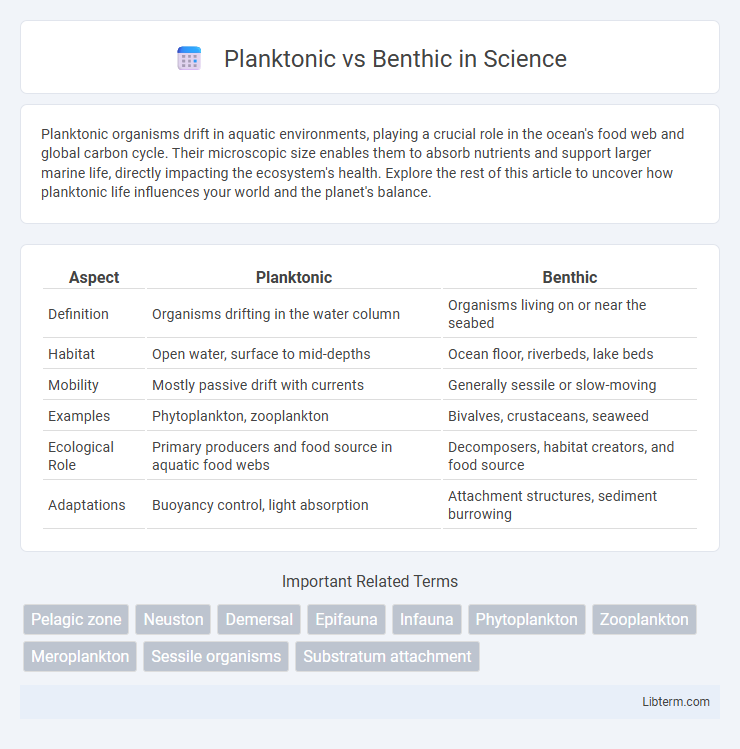Planktonic organisms drift in aquatic environments, playing a crucial role in the ocean's food web and global carbon cycle. Their microscopic size enables them to absorb nutrients and support larger marine life, directly impacting the ecosystem's health. Explore the rest of this article to uncover how planktonic life influences your world and the planet's balance.
Table of Comparison
| Aspect | Planktonic | Benthic |
|---|---|---|
| Definition | Organisms drifting in the water column | Organisms living on or near the seabed |
| Habitat | Open water, surface to mid-depths | Ocean floor, riverbeds, lake beds |
| Mobility | Mostly passive drift with currents | Generally sessile or slow-moving |
| Examples | Phytoplankton, zooplankton | Bivalves, crustaceans, seaweed |
| Ecological Role | Primary producers and food source in aquatic food webs | Decomposers, habitat creators, and food source |
| Adaptations | Buoyancy control, light absorption | Attachment structures, sediment burrowing |
Introduction to Planktonic and Benthic Organisms
Planktonic organisms are small, free-floating aquatic species that drift with water currents, playing a crucial role in marine and freshwater food webs as primary producers and consumers. Benthic organisms inhabit the bottom substrates of aquatic environments, including sediments and rocks, and contribute to nutrient cycling and ecosystem stability through activities like burrowing and detritus decomposition. These two groups represent distinct ecological niches, with planktonic species dominating the pelagic zone and benthic species thriving in the benthic zone, together supporting aquatic biodiversity and ecosystem function.
Defining Planktonic Lifeforms
Planktonic lifeforms are microscopic organisms that drift with water currents in oceans, seas, and freshwater environments, relying on buoyancy rather than active swimming to navigate. These organisms include phytoplankton, which perform photosynthesis, and zooplankton, which feed on other microscopic entities, forming the foundation of aquatic food webs. Unlike benthic organisms that inhabit the seabed, planktonic species are distributed throughout the water column, playing a critical role in global carbon cycling and oxygen production.
Characteristics of Benthic Communities
Benthic communities consist of organisms living on or within the seabed, exhibiting adaptations for sediment stability, reduced light, and variable oxygen levels. These communities include diverse species such as polychaetes, mollusks, crustaceans, and benthic algae that contribute to nutrient cycling and substrate modification. Their ecological roles involve organic matter decomposition and habitat formation, crucial for maintaining marine ecosystem health and biodiversity.
Key Differences: Planktonic vs Benthic Habitats
Planktonic habitats are characterized by organisms drifting in the water column, relying on currents for movement and typically inhabiting open ocean or freshwater environments. Benthic habitats consist of organisms living on or near the seabed or riverbed, often attached to substrates or burrowed in sediment, influencing nutrient cycling and sediment stability. Key differences include mobility, spatial distribution, and ecological roles, with planktonic species contributing to primary production and benthic species playing critical roles in decomposition and habitat formation.
Adaptations for Planktonic Survival
Planktonic organisms exhibit specialized adaptations such as transparent bodies to avoid predation, buoyancy regulation through oil droplets or gas vesicles, and slow sinking rates enabled by flattened shapes or spines. Their reproductive strategies often involve rapid asexual reproduction to quickly exploit favorable conditions. These traits contrast with benthic species, which are adapted for life on or near the seafloor with features suited for attachment, burrowing, or crawling.
Adaptations for Benthic Existence
Benthic organisms exhibit specialized adaptations such as enhanced anchoring structures, flattened bodies for substrate adherence, and sensory organs optimized for low-light or sediment-rich environments. These adaptations enable survival in high-pressure, low-oxygen conditions of the ocean floor, contrasting with planktonic species adapted for free-floating lifestyles. Benthos often develop slow metabolisms and symbiotic relationships with chemosynthetic bacteria to thrive in nutrient-scarce benthic habitats.
Ecological Roles in Aquatic Ecosystems
Planktonic organisms, including phytoplankton and zooplankton, are crucial primary producers and consumers in aquatic food webs, driving photosynthesis and nutrient cycling in the water column. Benthic organisms, such as worms, mollusks, and crustaceans, play key roles in sediment bioturbation, organic matter decomposition, and nutrient recycling at the bottom substrate of aquatic ecosystems. The interaction between planktonic and benthic communities regulates energy flow and supports biodiversity, maintaining ecosystem stability and productivity in freshwater and marine environments.
Nutrient Cycling: Planktonic vs Benthic Contribution
Planktonic organisms drive nutrient cycling in the water column by rapidly recycling nutrients through photosynthesis and decomposition, supporting primary production and fueling aquatic food webs. Benthic communities contribute by breaking down organic matter on the sediment surface, releasing nutrients back into the water column and facilitating sediment-water nutrient exchange. Together, planktonic and benthic processes maintain ecosystem productivity and biogeochemical balance in aquatic environments.
Human Impact on Planktonic and Benthic Populations
Human activities such as pollution, climate change, and coastal development significantly affect planktonic and benthic populations by altering water quality, temperature, and habitat structure. Increased nutrient runoff causes eutrophication, leading to harmful algal blooms that disrupt planktonic ecosystems, while sedimentation and habitat destruction severely impact benthic communities by smothering organisms and reducing biodiversity. Overfishing and chemical contaminants further exacerbate stress on both planktonic and benthic species, threatening marine food webs and ecosystem stability.
Future Research and Conservation Efforts
Future research on planktonic and benthic organisms will emphasize understanding their roles in biogeochemical cycles and ecosystem resilience amid climate change. Conservation efforts must prioritize habitat protection, addressing pollution, and mitigating ocean acidification to preserve biodiversity and ecosystem functions. Integrating advanced genomic tools and remote sensing will enhance monitoring and inform adaptive management strategies for these critical marine communities.
Planktonic Infographic

 libterm.com
libterm.com